An ongoing dialogue on HIV/AIDS, infectious diseases,
April 21st, 2023
A Change-of-Season ID/HIV Link-o-Rama

Bug, from Martin Frobenius Ledermüller’s Microscopic Delights (1759–63)
The warm weather takes its sweet time to arrive here in Boston, teasing us with an occasional comfortable day, but reverting frequently to chilly temperatures and high winds until mid-to-late May at the earliest. The afternoon sunlight might say, “Spring is here!”, but the nightly temps in the upper 30s/low 40s definitely say otherwise. Brrr.
Anyway, here are a bunch of assorted ID/HIV links of note, as the weather in Boston can’t decide between winter and summer — and eventually will skip spring entirely, as usual:
- Postexposure prophylaxis with one 200-mg dose of doxycycline reduced the risk of bacterial sexually transmitted infections (STIs). Based on this and two other studies from France, there is little doubt this strategy works. The key will be implementing it in the right population, which for now appears to be men who have sex with men (MSM) or trans women with a history of recurrent or multiple STIs. And of course, long-term risks (resistance, other adverse effects) remain unknown.
- An experimental RSV vaccine given during pregnancy reduced the risk of “medically attended” severe RSV-associated lower respiratory tract illness in infants. This was one of the co-primary endpoints; the vaccine was not significantly better than placebo for any medically attended RSV-associated lower respiratory tract illness within 90 days after birth. An accompanying editorial appropriately describes the “complex policy decisions” about whether to offer this vaccine to pregnant women, as another RSV vaccine did show a signal of increasing the risk of premature birth — one not observed here.
- A large study of statin versus placebo in people with HIV was stopped early due to efficacy. Participants were at low-to-moderate risk of myocardial infarction (MI), and had stable HIV disease; pitavastatin reduced the risk of major cardiovascular events by 35%. One particular area of interest will be how strong the signal of benefit is across baseline characteristics — I suspect that relative risk reduction will be preserved, but for some, the absolute risk will be quite low, limiting uptake. But add this study to the “put statins in the water” team.
- Prophylactic piperacillin-tazobactam prior to pancreatoduodenectomy (better known as a Whipple procedure) reduced postoperative complications significantly more than cefoxitin. The study stopped early due to the large beneficial effect of pip-tazo (which is how I avoid saying the expired brand name). This is the kind of clinical trial for common clinical strategies in ID we should see more often! I strongly suspect this one will change clinical practice guidelines.
- HIV incidence was higher among men choosing event-driven rather than daily PrEP. An important paper given both the relatively understudied population (MSM in West Africa), and the results — adherence to the event-driven strategy was significantly lower, clearly influencing the outcome.
- In a randomized clinical trial, participants receiving fluvoxamine plus inhaled budesonide had fewer ER visits or hospitalizations or complications due to COVID-19 than those getting placebo. Note that the dose of fluvoxamine is 100 mg twice daily, 2 times higher than in the negative COVID-OUT study. These positive randomized clinical trials (see metformin) in people immunized and/or previously having had COVID-19 ironically offer more direct evidence of clinical benefit in this immune population than molnupiravir — and some would say nirmatrelvir/r as well.
- In Staph aureus bacteremia, combination therapy with cloxacillin plus fosfomycin was no better than cloxacillin alone. We’re still awaiting a combination therapy study that shows “more is better” for this challenging clinical entity. The study was presented at the European Society of Clinical Microbiology and Infectious Diseases, often abbreviated to “ECCMID” — which is rapidly emerging as one of the premiere clinical infectious diseases meetings in the world.
- A man died of rabies even though he received appropriate postexposure treatment. In this, the first report of such postexposure prophylaxis failure, the authors speculate that his immunocompromised status was the cause. And while each detailed report of rabies reads like something from a horror movie — and keeps us ID docs up at night — an excellent accompanying commentary reminds us that rabies is very, very rare in the United States. Fortunately.
- Treatment with nirmatrelvir/r was associated with a lower risk of developing long COVID. Observational studies such as this one, which cannot adjust for unmeasured confounders, do not prove that treatment reduces the risk of long COVID, but they strongly suggest it — especially with the favorable results of the ensitrelvir placebo-controlled, randomized clinical trial, which I have summarized previously.
- A high dose of a nonpathogenic, nontoxigenic, commensal strain of Clostridia species significantly reduced the risk of recurrent Clostridioides difficile infection compared to placebo. The treatment, called VE303, came originally from healthy human stool samples, then was amplified using clonal cell banks. Though this is a small study requiring confirmation, these data plus those from the SER-109 trial strongly suggest that microbiome-based treatment will one day be part of C. difficile treatment and prevention strategies.
- Can fecal microbiota transplantation (FMT) be a viable treatment for patients who suffer from recurrent multidrug-resistant urinary tract infections (UTIs)? This is a tiny (n=5) but promising case series, showing reduced frequency of UTIs and decreased hospitalizations after FMT. Every ID doctor knows just how common multidrug-resistant UTIs are today, with much attendant misery.
- The “adjuvanted” HBV vaccine (Heplisav) induced protective antibody responses in 100% of vaccine-naive people with HIV (PWH). Importantly, the usual response to this vaccine among adult PWH is suboptimal (20-70%), so these are remarkably good results. A study with this vaccine in PWH who don’t respond to hepatitis B vaccine is ongoing.
- Candida auris is spreading — fast. A particularly worrisome observation from this CDC surveillance study is that echinocandin resistance was 3 times higher in 2021 than in the previous two years. Yikes.
- An outbreak of blastomycosis in a Michigan paper plant has sickened nearly 100 people. One person has died. This is the first non-lab occupational outbreak of this endemic fungal infection I can recall, and it is still undergoing investigation.
- A physician-patient described the experience of being sent home on IV oxacillin. The clinicians treating her chose this strategy despite her protests (she preferred an oral option) and, not surprisingly, the experience was not a good one. This account should be required reading for all who do hospital-only patient care to understand just how dismal the “OPAT” — outpatient parenteral antimicrobial therapy — experience can be.
- Should masks still be required in all healthcare settings at all times? It’s a nuanced pro and con look at universal masking in hospitals and clinics, ultimately concluding that the time for this strategy has passed. The authors are infection preventionists, many of whom I know well (disclosure). Certainly, there are strong opinions on this matter on both sides of the debate — here’s an alternative view.
- Universal testing of admitted patients for COVID-19 may have unintended negative consequences. In this prospective study of 2,794 admissions, 129 (4.6%) tested positive by PCR, and 54 (41.9%) were asymptomatic. From this group, 39 had a cycle threshold of >35 and were deemed noninfectious. Nonetheless, 23 had adverse consequences, such as delayed medical care, canceled surgeries, or inappropriate treatment. The flip side, of course, is that universal testing also may prevent in-hospital transmissions. We’re clearly in a transition phase in healthcare for both universal masking and testing!
- Differential time to positive blood cultures acts as a helpful diagnostic tool in diagnosing central line-associated bloodstream infections (CLABSIs). In this systematic review of over 20 studies, if the blood culture from the central line turned positive 2 hours faster than the peripheral blood culture, CLABSI was highly likely. An important caveat is that this didn’t do very well for Staph aureus or Candida spp., but we generally recommend line removal for these pathogens anyway.
- Antibiotic exposure is associated with an increased risk of inflammatory bowel disease. As noted by my colleague Dr. Sanjat Kanjilal, who alerted me to this paper, this large, population-based study shows that antibiotics have way more “off target” effects than just resistance, C. diff., and side effects.
Hey baseball fans — how are you liking the pitch clock? I’m loving it!
Landon Knack throwing an entire half inning vs. Pedro Báez throwing 1 pitch. pic.twitter.com/wHa2p6K7k8
— Rob Friedman (@PitchingNinja) February 27, 2023
April 8th, 2023
Travel Clinics and a Travel History to Beat All Travel Histories
 Dear All,
Dear All,
I’ve received some very helpful and quite critical comments about the original post that was here. Having re-read the original, I’m acknowledging my mistake and want to apologize to my colleagues, many of whom do travel medicine with true expertise, excellent intentions, and for the benefit of travelers everywhere. My bad for not emphasizing this fact in the first part of the post.
Awaiting input from my editors, I temporarily removed it yesterday, but now have replaced it below. There are some edits to parts that I especially regret, but the essence is there.
Thanks everyone for reading, and helping me keep this a useful, supportive, and I hope educational place.
Paul
Confession: I have mixed feelings about travel clinics.
On the one hand, they provide a useful service to people who might be unaware of the dangers of the exotic places they plan to visit. It’s a place for sensible counseling:
Don’t eat street food! Don’t play with the stray dogs! Don’t swim in the Omo River!
Travel clinics offer a cornucopia of vaccines — yellow fever, typhoid, hepatitis A, rabies. A good travel doctor or nurse — optimally an experienced and enthusiastic traveler themselves — really knows the risk of Japanese encephalitis on your 3-week trip to Myanmar. They also have wise advice about malaria prophylaxis and other treatments to take along, just in case.
Plus, falling outside of many insurance plans and serving a generally well-to-do crowd, travel clinic is one of the few places ID doctors generate revenue in the outpatient setting. These money-makers are so few and far between for us that it’s hard to pass them up.
We have an active travel clinic, and the patients are really happy to have this convenient, one-stop service. They love it! And our travel clinic providers are great. Demand is sky-high, showing a reassuring return to pre-pandemic travel.
All good so far.
On the other hand, travel clinics sometimes cater to the worried well, offering dubious value if the destination is simply a long trip, the planned activities not so risky. Does the business traveler to Bangkok or Johannesburg, the honeymooner to Fiji, or the tennis enthusiast going to a resort outside of Buenos Aires really need to go to a travel clinic before their trips? Of course not, yet I’ve seen all of these examples come through our doors.
Additionally, the education component can paradoxically make the worried traveler feel worse. A recently retired ID doctor here in New England regularly did travel clinic at his hospital, but so hated to travel himself that he sometimes bluntly told his patients — “Look, if it were me, I wouldn’t go.” No doubt he was responsible for a high volume of canceled first-class airfares.
Last, some of the people who really need travel clinics can’t access them because, as mentioned, insurance often doesn’t cover it. This creates a two-class level of care analogous to traveling business vs. coach, but since it involves healthcare, is far more disquieting.
Travel clinics are on my mind because I recently had the distinct pleasure of reconnecting with a college friend, Mike Reiss. Professionally a comedy writer (he’s one of the original writers for The Simpsons, among other credits), Mike loves to travel.
Or more accurately, Mike’s wife Denise loves to travel, and Mike is totally smitten with Denise and will do whatever she wants.
Let me emphasize that “loves to travel” barely begins to describe their enthusiasm. They’ve now logged well over 100 countries, travel regularly to places you have not been (trust me on this one), and have had some remarkable experiences — many of which Mike details in his podcast, What Am I Doing Here?, which I highly recommend.
Mike chatted with me recently, and our conversation is incredibly funny — that’s because everything Mike talks about is incredibly funny! Listen here at the bottom of this post, or wherever you get your podcasts. You won’t want to miss it. His travel history reads like a parody of an ID certification exam question.
And Mike, here’s some friendly advice — if you don’t want to go to a travel clinic, here are the big four I’d recommend for a traveler like you, easy stuff you can get from your primary care doctor:
- Get the hepatitis A vaccine. Two shots, you’re good for a lifetime.
- Typhoid vaccine if indicated — either the shot or the pills.
- Take some azithromycin with you in case of severe traveler’s diarrhea.
- If you’re going to a malaria hotspot, take malaria prophylaxis.
Even better, check out the CDC’s travel web site. I use it all the time.
March 27th, 2023
Three Effective Treatments for COVID-19 Not in Treatment Guidelines — at Least Not Yet
 A few weeks ago, in a patented (and copyrighted and trademarked) Really Rapid Review™, I summarized some of the Greatest Hits from CROI 2023. The conference included new data on not just HIV, but also a grab bag of opportunistic infections, STIs, viral hepatitis — and, as has been the case since 2020, COVID-19.
A few weeks ago, in a patented (and copyrighted and trademarked) Really Rapid Review™, I summarized some of the Greatest Hits from CROI 2023. The conference included new data on not just HIV, but also a grab bag of opportunistic infections, STIs, viral hepatitis — and, as has been the case since 2020, COVID-19.
You know, right in the wheelhouse of readers like you.
At least most of you. Wrote one longtime fan after that post:
Paul,
That was undoubtedly the most boring blog post you’ve ever done.
Mom
Um, certainly no one ever accused my mother of hiding her true feelings!
Risking again putting this very same reader to sleep, I bring you now more data presented at CROI — three studies highlighting promising outpatient COVID-19 treatments. The full presentations are now available on the CROI website, and I’ve linked them below:
1. Ensitrelvir. A SAR-CoV-2 protease inhibitor like nirmatrelvir, ensitrelvir at two doses was compared to placebo in a randomized trial done in people at low risk for severe outcomes — meaning younger (12–69 years old), mostly vaccinated, and lacking risk factors for severe disease.
Ensitrelvir shortened the duration of symptoms by about a day (the primary endpoint) and hastened the time to the first negative SARS-CoV-2 viral test. Perhaps most importantly for this group at low risk for hospitalization but still vulnerable to long COVID, a questionnaire targeting symptoms of long COVID conducted at 3 and 6 months showed a significant reduction in the treatment group compared to placebo. The protective effect was greater in those with more severe disease at start, the people at greatest risk of getting this complication to begin with.
Based on these results, I think these are the strongest data we have that antiviral therapy reduces the likelihood of developing long COVID. Yay to that. Note that ensitrelvir already has approval for treatment of COVID-19 in Japan.
2. Metformin. In the quest for “repurposed” drugs for COVID-19, the hits (dexamethasone, tocilizumab, baricitinib) lose badly to the misses (lopinavir/ritonavir, hydroxychloroquine, ivermectin, azithromycin, colchicine, fluvoxamine, numerous others), especially for outpatient treatment. Could metformin be the exception?
At CROI, the investigators of the COVID-OUT study presented data on their randomized clinical trial of metformin versus placebo. Treatment was significantly better in a composite outcome of emergency department visits, hospitalizations, or death; the drug also demonstrated a significant antiviral effect. Furthermore, long-term follow-up found that treated patients were less likely to receive a diagnosis of long COVID by their providers.
Add to these benefits the widespread familiarity that clinicians have with this drug, its well-established safety profile, and its extraordinarily low cost, and we might have a winner here, folks.
3. Pegylated interferon lambda. Need I say more?
I won’t pretend there aren’t issues with these three studies. Here are a few worth exploring:
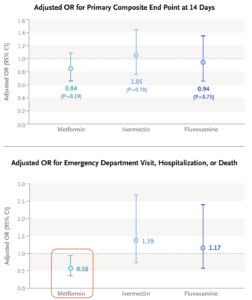 Ensitrelvir: The study evaluated two doses of the drug, 125 mg and 250 mg once daily; the lower dose appeared to be more effective, for unclear reasons. Plus, the long COVID endpoint analysis I highlighted was not protocol-specified, and hence must be considered exploratory.
Ensitrelvir: The study evaluated two doses of the drug, 125 mg and 250 mg once daily; the lower dose appeared to be more effective, for unclear reasons. Plus, the long COVID endpoint analysis I highlighted was not protocol-specified, and hence must be considered exploratory.- Metformin: The primary endpoint of the metformin COVID-OUT study, which included home oxygenation results as part of a composite clinical endpoint, was negative. Subsequently, the investigators learned that the home oxygenation results were unreliable, which undoubtedly introduced a lot of noise into analysis of this endpoint. Note that the positive secondary endpoint for metformin (emergency room visits, hospitalization, or death) did make it onto the Research Summary (see figure — edit mine), but it’s not the message most take from the published paper.
- Pegylated interferon lambda: The TOGETHER trial enrolled patients in Brazil (mostly) and Canada; this study previously yielded favorable results with fluvoxamine. Given the subsequent negative results with fluvoxamine, should we be skeptical of any data coming from this study?
Still, there’s a lot to like here with all three treatments, especially given our limited current options now that monoclonal antibodies are gone. And importantly, the three outpatient therapies — Paxlovid, molnupiravir, intravenous remdesivir — have their own issues, some of which I’ve summarized previously.
Some might think we’re done with COVID-19, so why invest in studying further treatments? To those people, let’s face facts — this respiratory virus isn’t going anywhere, still accounts for hundreds of deaths a week in medically vulnerable populations, and causes enormous disruption in workplaces and schools. An annual bump in cases each respiratory virus season is all but a certainty given what we’ve seen the past three winters.
If you’re interested in hearing more details about these novel treatments, how they might compare to what we currently have, and how they could be investigated further, listen to the discussion I had with University of Minnesota’s Dr. David Boulware on an IDSA podcast, just released. He truly deserves the label “clinical trialist extraordinaire,” which is how I introduce him.
It’s available on the IDSA site along with a transcript, or wherever you get your podcasts, or right at the bottom of this post.
Hey Mom — am sure you’ll love it!
March 16th, 2023
Oral Antibiotic Therapy for Endocarditis — Are We There Yet?
Two terms in clinical research appear frequently in abstracts, conference presentations, and published papers — “clinical practice” and more recently, “real-world.”
Many research snobs turn up their noses at both, finding them imprecise or pretentious. I confess to flinching each time I read “real-world” — isn’t everything “real-world”? If not, what’s the opposite? Mouse studies? (They’re certainly the real world from the mouse’s perspective, though not in a way that they would like.) Work done “in silico”? Trial participants recruited from the film Avatar?
But having collaborated in several real world studies over the years, I realize there is a reason to signal that data come from actual clinical practice — that is, derived from people in care, outside the specified and restricted domains of a prospective research protocol.
One such paper just appeared in Clinical Infectious Diseases, entitled “Real-world Application of Oral Therapy for Infective Endocarditis: A Multicenter Retrospective, Cohort Study”.
Here I’d argue that this “real-world” description is highly appropriate — because, as the authors note, despite evidence from randomized clinical trials on the efficacy and safety of oral therapy to complete treatment for endocarditis, uptake of this practice remains highly limited. We need people to report what they’ve seen after implementing this novel strategy.
The authors cite experience within their healthcare system in 46 patients treated with oral therapy, compared with 211 who received IV. Importantly, these cases occurred after their system implemented an “Expected Practice” document sanctioning oral therapy in stable patients with no contraindications.
Here are the results:
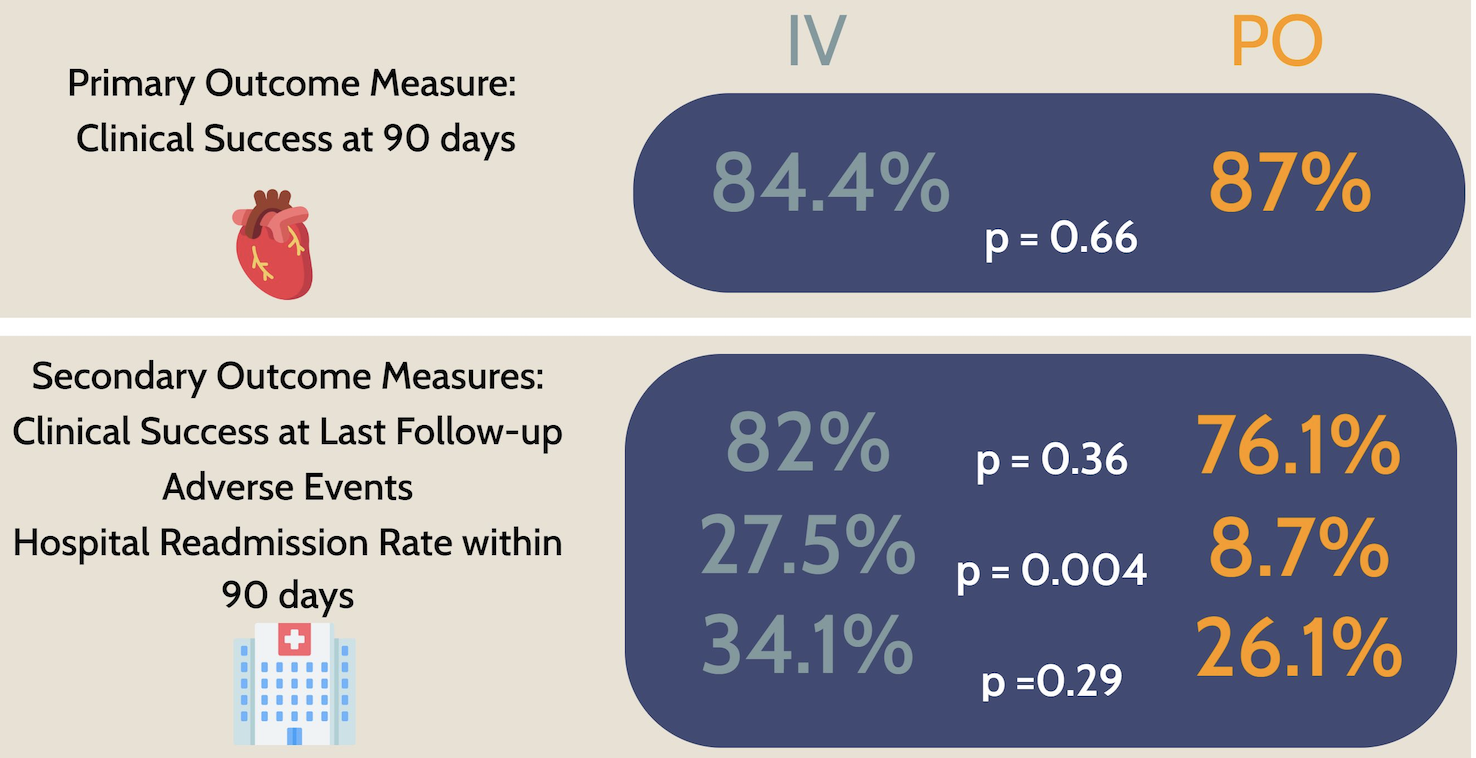
Looks great! As no fan of outpatient parenteral antimicrobial therapy (OPAT), I was delighted to see that adverse events occurred significantly less often in the oral treatment group.
Skeptics will argue that the biggest limitation of these data is that, like all nonrandomized studies, baseline differences between the two groups could have influenced the outcomes independent of the type of treatments they received. Specifically, the IV-only group was older with more comorbidities, while the oral antibiotic group had a higher proportion with a history of injection drug use. A multivariable regression analysis factoring in these differences did not demonstrate a significant impact on outcomes, but unmeasured differences cannot be accounted for.
Limitations notwithstanding, the study provides helpful reassurance about the practice of using oral therapy to complete treatment for endocarditis — a practice that would have been unimaginable a decade ago.
Curious to hear from readers, especially ID docs, pharmacists, and other clinicians doing hospital-based medicine — are you using oral therapy for endocarditis?
If so, in what settings?
February 28th, 2023
Really Rapid Review — CROI 2023, Seattle
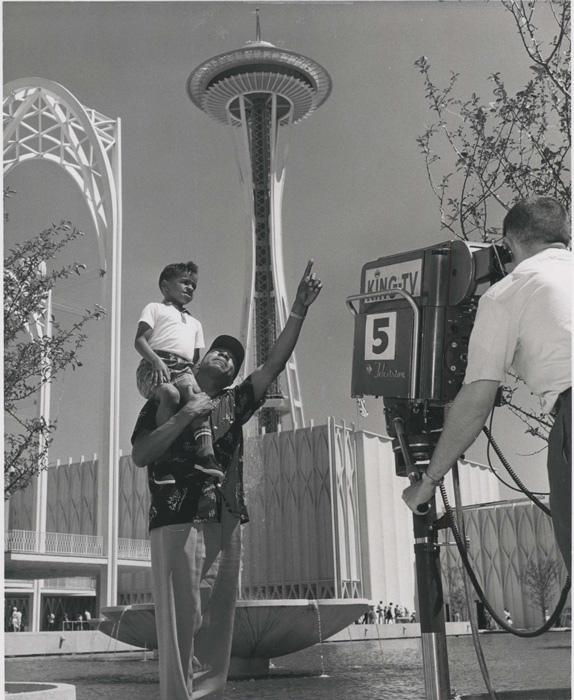
“Look up there! It’s Microsoft and Amazon stock!” National Archives, 1962.
In a recent chat I had on a local TV network on this year’s respiratory virus season, the host mentioned that “this year felt very post-pandemic”, prompting me reflexively to knock wood — and I’m not a superstitious person.
But even we ID doctors must acknowledge the dramatic improvement in COVID severity this winter compared to the last two, both of which were severe enough to make the Conference on Retroviruses and Opportunistic Infections, or CROI, stick to the virtual-only format. And, of course, historically, CROI was the very first scientific conference to go this route, way back in March 2020, a period about which the less said the better.
(Involuntary shudder.)
But on to this year’s CROI, which was available in-person or virtual, taking place once again in Seattle, a place it’s been several times before. It’s our premiere scientific conference, covering not just HIV, but also sexually transmitted infections (STIs), hepatitis, and now SARS-CoV-2, with many excellent studies on all these scourges.
This week, in this Really Rapid Review™, I’ll cover the non-COVID studies, with take-home messages and sometimes a brief comment. You’ll see the abstract numbers in brackets and links to either the abstract (if available) or to the invaluable NATAP site, which somehow continues to aggregate many of the actual slide presentations and posters in real-time. Bravo for that, and long may it live!
- The prognosis for people with HIV has markedly improved since 2012 [870]. This multi-national, large (n=33,598) cohort study demonstrated a significant drop in risk of death during this period, regardless of cause. The leading cause of death was non-AIDS-related cancers, an observation likely to resonate with all HIV providers. Among HIV factors, CD4 <350 and RNA >200 were the strongest predictors of death.
- After treatment failure with NNRTI + 2NRTIs, DTG plus DRV/r was both noninferior and superior to standard of care [198]. This is the first time a boosted PI plus an INSTI has bested a regimen of recycled NRTIs plus a boosted PI. Given the widespread use of DTG + 2NRTIs as fixed-dose “TLD”, which also performed well in this study, I suspect the DRV/r + DTG strategy will not be used much. FYI, the study is called “D2EFT” for “Dolutegravir and Darunavir Effectiveness in adults Failing first-line Therapy” — you knew that, right?
- Switching stable PWH on BIC/FTC/TAF to long-acting injectable CAB-RPV every 2 months resulted in noninferior virologic suppression at 12 months [191]. 670 PWH were randomized 1:2 to continue versus switch to 2-monthly CAB-RPV. While the results met the criteria for noninferiority, there were 5 people on CAB-RPV (3 with resistance) with viral loads >50 in the injectable group, versus 1 in the BIC/FTC/TAF group (no resistance). Counseling people considering CAB/RPV that this therapy comes with a small (but non-zero) risk of failure with resistance is important. Treatment satisfaction improved with the switch. This is the SOLAR study, for “Switch Onto Long-Acting Regimen” — now that’s a good name!
- Switching from BIC/FTC/TAF to CAB/RPV does not lead to weight loss [146]. Data are from the above clinical trial. Meaning — do not use “maybe they will lose weight” as the motivation for the switch to long-acting injectables. Some people gain weight, some people stay stable, some people lose.
- What influences switches to either BIC/FTC/TAF or DTG/3TC [532]? The former is chosen more for those with low CD4 or risk factors for poor adherence; the latter for renal impairment or obesity. So even though these have similar indications, they are not used identically in clinical practice. (Co-author disclosure.)
- Having a detectable viral load in the year preceding a switch to CAB-RPV is a risk factor for detectable viremia following the switch [516]. This study, from the UCSD clinical program that has adopted CAB-RPV more enthusiastically than any other clinic site I’m aware of, found that 25% of switchers end up having detectable viral loads post switch — I’m sure engendering much anxiety! Importantly, one of the investigators told me that failure with resistance in their clinical cohort occurs at a rate comparable to the clinical trials (approximately 1-2%).
- PWH with uncontrolled viremia achieved high rates of virologic suppression on CAB-RPV [518]. More from the UCSF Ward 86 cohort, using CAB/RPV in a non-FDA-approved strategy. Out of 133 PWH who were very much not the usual candidates for this treatment, 57 had viremia. Suppression was achieved in 55 — astoundingly good — with only 2 developing treatment failure. A corresponding modeling study [517] showed this strategy would greatly prolong survival, even with conservative estimates about efficacy (co-author disclosure). We need this success with IM CAB/RPV in people with viremia replicated elsewhere! If it is, I suspect it could enter treatment guidelines, of course with all kinds of caveats and cautionary language.
- Lenacapavir plus two long-acting broadly neutralizing antibodies (bNAbs) given every 6 months maintained virologic suppression for 26 weeks [193]. Out of 20 participants, 1 rebounded — unclear why. A study entry requirement was pre-treatment resistance testing showing susceptibility to the bNAbs — a big hurdle if this form of treatment is ever going to be practically deployed. Another hurdle — saying the names of the bNAbs. From an always amusing friend:

- Islatravir (ISL) causes a dose-related drop in lymphocytes that resolves over several months [192]. Welcome back, islatravir! The suspected mechanism of this drop is intracellular accumulation of ISL-triphosphate, leading to apoptosis — not mitochondrial toxicity. The dose moving forward will be 0.25 mg daily, which should be active against wild-type and M184V-containing viruses; the weekly dose (when combined with lenacapavir) will be 2 mg. These data preceded presentations on two phase 3 switch studies of doravirine/islatravir (DOR/ISL) in stably suppressed PWH.
- Stable PWH on any regimen maintained virologic suppression comparable to their baseline treatment when switching to daily DOR/ISL [196]. There were no treatment failures on DOR/ISL versus 3 in the continued baseline regimen in this open-label study.
- Stable PWH on BIC/FTC/TAF maintained virologic suppression when switching to daily DOR/ISL [197]. This was a blinded study and encouragingly showed no difference in treatment-related side effects except for a drop in lymphocytes. (0.75 mg daily of ISL used.) There was a question from the audience about weight changes, which were not presented, but are in the public domain — no significant changes at 48 weeks after the switch. For the record, I have it on good authority that we’re not supposed to call this regimen “door-isil”.
- The weight trajectory of over 20,000 PWH in Kenya switching to dolutegravir differed by baseline regimen [617]. People switching off efavirenz had a sharp increase in weight, one not observed with baseline nevirapine — a reminder that weight effects within drug classes are not uniform, as only efavirenz (among the NNRTIs) appears to have this weight-suppressive effect.
- Weight decreases when TAF/FTC + DTG is switched to “TLD” and increases when the switch is from TDF/FTC/EFV [671]. These changes are exactly as one would predict, as the “T” stands for TDF — which has been shown in multiple studies to suppress weight, in particular when combined with EFV. The mechanism remains unclear. Linked the published clinical study from CID.
- An in vitro model showed that dolutegravir, but not doravirine or efavirenz, disrupted estrogen-mediated fat differentiation [147]. Is this the explanation for the greater weight gain on INSTIs for women than men? By the way, the full title of the presentation was A LOSS OF ERα ATTENUATES DTG-MEDIATED DISRUPTION OF THERMOGENESIS IN BROWN ADIPOCYTES, in case you were wondering. (Abstract not available.)
- Could alteration in GI microflora explain the weight differences between regimens [248]? Gut microbiota among 27 PWH switching treatment from TDF/FTC/EFV to BIC/FTC/TAF showed increased diversity (generally a sign of health), but also increased sC163 (an inflammatory marker associated with obesity) — cause versus effect? There were no controls in this study.
- When controlling for baseline risk factors, integrase-inhibitor-based regimens were not associated with elevated cardiovascular risk [149]. This is reassuring data from the Swiss HIV Cohort study, contrasting with published data from a different cohort. I confess I held my breath when reading the title of the presentation, as this class of drugs is now critical to HIV treatment worldwide.
- Multivariable analysis of a clinical trial comparing BIC/FTC/TAF and DTG+F/TDF showed that TAF looks better for HBV [116]. Predictors of HBV suppression were HBeAg-, HBV DNA <8 log, ALT >ULN and treatment w BIC/FTC/TAF. Longer follow-up of this study, presented originally at the AIDS 2022 meeting, will be important as the TDF-based regimen may eventually catch up.
- Doxycycline given as post-exposure prophylaxis after sex reduced the incidence of syphilis, chlamydia, and gonorrhea in MSM [119]. In a second randomization, the meningococcal B vaccine reduced the incidence of gonorrhea. Called the DOXYVAC study, this was one of several key presentations on the doxycycline preventive strategy during the conference.
- An analysis of bacterial resistance from the Doxy-PEP study found no increase in resistance to GC, Staph aureus, or commensal Neisseria species with PEP [120]. Reassuring data! One caveat is that resistance could happen eventually if this strategy were widely adopted. As a reminder, Doxy-PEP also found that bacterial STIs declined in MSM and trans women who took PEP, as did the original ANRS study (albeit not for GC). That makes 3 favorable studies for doxy-PEP and STI prevention in MSM.
- In women at high risk in Kenya, doxycycline PEP did not reduce bacterial STIs [121]. It’s uncertain why this intervention was not effective in cisgender women — adherence was good, and a separate PK study [118] implied that it should have worked.
- A modeling study applying favorable data on doxycycline PEP to MSM and trans women found that adopting this strategy for those with prior STIs would avert a substantial number of future infections [122]. Not surprisingly, a robust discussion ensued at this session about whether guidelines should recommend doxycycline PEP for certain populations. Though I’m not on guidelines committees for STIs, I’d vote yes — with ongoing surveillance studies for assessment of resistance. Although we use doxy-PEP for tick bites for Lyme areas, this intervention for STIs is likely to be much more frequent.
- Mpox in PWH who have advanced HIV-related immunosuppression can be a severe, disfiguring, and life-threatening opportunistic infection [173]. Mortality was 27% (!) in those with CD4 <100, and the clinical course suggests an IRIS-like phenomenon when ART is started. There is a graphic (and unsettling) display of the Mpox lesions in the published paper. These cases underscore how critical it is for PWH to get on HIV therapy before the disease progresses and also to get at-risk people vaccinated.
- A study of over 6000 women receiving TDF/FTC for PrEP found that the adherence correlates with protection were similar to what’s observed in men [516]. Effectiveness increased steeply with 4 or more pills/week. Previous studies suggested that women required higher levels of adherence than men.
- HIV acquired while receiving PrEP with cabotegravir may be clinically silent and difficult to diagnose [149]. The investigators described delayed detection, negative antigen/antibody tests, and a paucity of symptoms. They even gave this syndrome a name — LEVI, for “Long-acting Early Viral Inhibition” syndrome. Not bad. The key is to use HIV RNA for diagnosis, but these are still going to be very challenging. Here’s a real-life case, occurring in clinical practice.
Had an amazing time at #CROI2023! We were able to share our real world case of breakthrough HIV-1 infection in the setting of on-time, appropriately monitored CAB-LA for PrEP @howardbrownhc.
We greatly appreciated the insightful discussions which I’ll try to summarize below. pic.twitter.com/iLI7WtJSMj
— Anu Hazra (@AnuHazraMD) February 22, 2023
- A complex TB treatment strategy of 8 weeks (!) of bedaquiline + linezolid added to INH, PZA, and ethambutol was noninferior to the standard 6 months of therapy [113]. The study, called TRUNCATE-TB, was just published in the New England Journal of Medicine. But before getting too excited, there are caveats about implementing this challenging approach — lots of them! There is a good summary of these concerns in the accompanying editorial and in this thread.
Of course, there were numerous additional interesting studies not mentioned here, apologies if I left out your favorites — feel free to cite them in the comments.
And it was really fun to visit Seattle again, a place with a strong familial connection. Plus, the sparkling new wing of the convention center hosted the conference.
The weather? Cold and rainy — winter in Seattle, you know — and it even snowed a bit the last day. No one ever accused the CROI organizers of picking their winter locations in tropical paradise, that’s for sure.
February 14th, 2023
Interferon Lambda for COVID-19 — Looking Good, but Still Not Available
Way back in the spring of 2022, I was asked to give an update on outpatient treatment of COVID to a group of general internists. The talk featured this slide on the TOGETHER trial of peginterferon lambda:
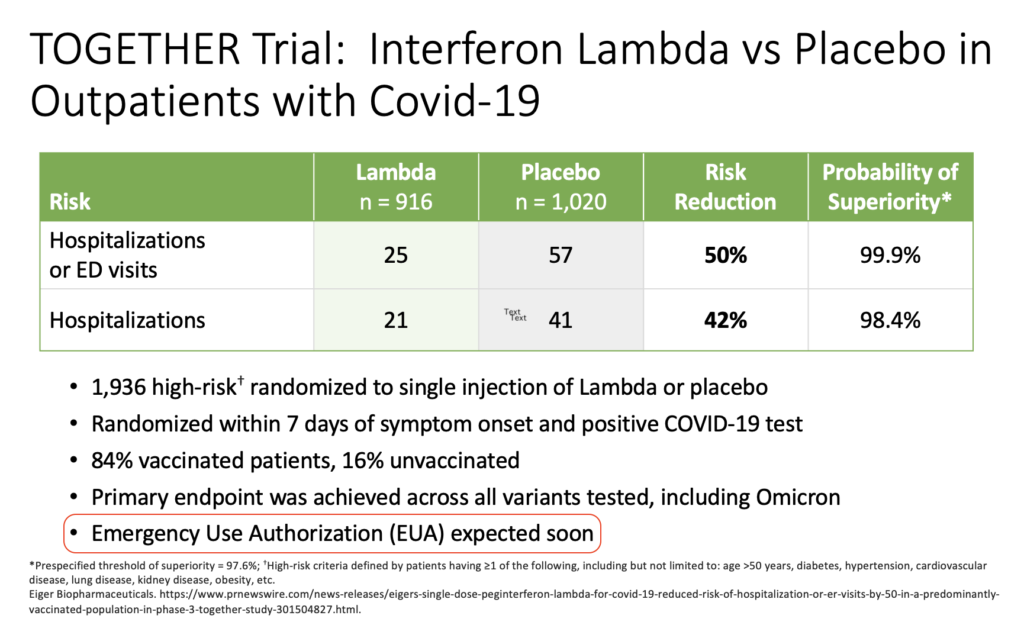
These data came from a press release from the company developing the drug. It’s dated March 17, 2022.
I added the highlight over the last bullet to make fun of my very bad prediction. Oops. Clinicians who treat COVID, or have known people treated for COVID (which covers essentially 100% of the U.S. adult population at this point), realize we still don’t have interferon lambda as a treatment option, now nearly a year later.
I summarized the reasons for my initial optimism in an opinion piece for the Boston Globe written with Dr. David Boulware (clinical trialist extraordinaire), namely:
- Efficacy shown even in vaccinated people
- Worked across all variants
- Dropped viral loads faster
- Side effects comparable to placebo
- “One and done” treatment
- No drug interactions
- Might work against other viral infections too!
Yep, the TOGETHER trial interferon results — published this past week in the New England Journal of Medicine — look really solid.
It’s not a perfect clinical trial. There were some issues with the drug supply during the study, and the blinding, and some have criticized the primary endpoint. There were apparently enough concerns that the FDA did not agree to meet with the company to discuss an Emergency Use Authorization. But all studies have weaknesses. I don’t think these are sufficient to invalidate the results.
Plus, it’s worth remembering that our current COVID treatments are hardly flawless. None of our treatments has documented efficacy in vaccinated high-risk outpatients. Other issues:
- Molnupiravir may not be effective at all — and has legitimate safety concerns.
- Paxlovid has a boatload of drug interactions and that annoying rebound syndrome that we still don’t know how best to predict or manage. Grrrr. (That’s annoyance.)
- Three days of intravenous remdesivir is cumbersome to set up, requiring either a visit to an infusion center or dedicated home care services, and hence is out of reach for many.
- Omicron and its subsequent mutations made all the previously available monoclonals inactive. So if you spent many hours learning how to spell (or pronounce) bamlanivimab, casirivimab, imdevimab, etesevimab, sotrovimab, tixagevimab, cilgavimab, or bebtelovimab, consider that a sunk cost.
I’ll acknowledge that reduced disease severity lowers the urgency of introducing a new therapy for COVID. Nevertheless, hundreds of people a day are still dying, and this virus isn’t going away anytime soon. Here’s a not-so-bold prediction — we’ll see a surge of cases pretty much every late fall and winter for the foreseeable future.
And having interferon available for COVID would greatly facilitate studying its use in other viral respiratory tract infections. Its mechanism of action, augmenting the host immune response to viral infections, could show activity across a broad spectrum of such pathogens — influenza (including H5N1) and RSV most notably, but even other common viral pests (metapneumovirus, rhinovirus, the pre-SARS-CoV-2 coronaviruses). I contacted the TOGETHER study’s senior author, Dr. Jeffrey Glenn, who wrote:
I have been advocating for a trial I call the RELIEF (REspiratory viruses treated with Lambda IntErFeron) study, where patients who present with acute respiratory symptoms are immediately randomized to lambda or placebo, and we sort out later what virus they have. This could generate more data in COVID, but importantly advance the ball further by generating new data for other viruses of pandemic potential. We could leverage the same great infrastructure of the TOGETHER trial and hopefully generate game-changing data.
So, here’s hoping this promising and novel therapy gets another chance, perhaps in this confirmatory study.
Oh, and by the way, my Globe piece prompted this email from my daughter Mimi:
Go dad!! Great title.
Yep, it’s one of my better ones.
February 6th, 2023
New Ways with Language — Some to Adopt, Some to Question
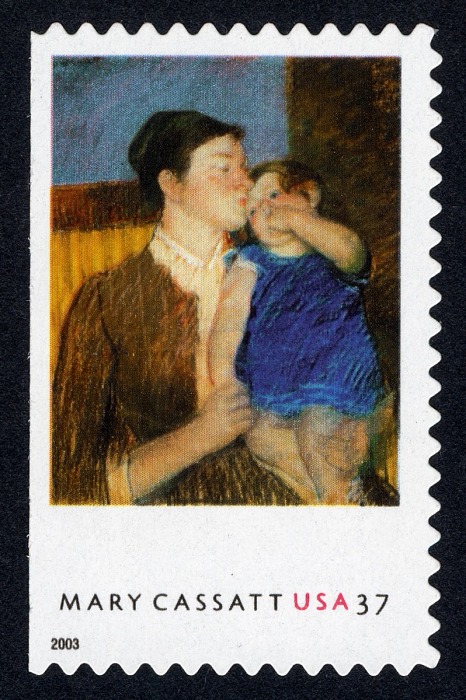
Mary Cassatt, Young Mother, 1888. US Postal Service stamp, 2003.
Back in my second year of medical school, my classmate and good friend John and I had a memorable teacher in our Introduction to Clinical Medicine course, someone we still talk about today. A general internist with a specialty in addiction, he was a big bear of a guy sporting a ponytail, beard, open-necked shirts (sometimes of the Hawaiian variety) and beads.
You know those stereotypes of Boston academic physicians with bow ties and tweeds? The opposite of that.
One of his emphatic messages was to stop labeling people by their diseases. “He’s not an alcoholic,” he’d say, after we’d done an awkward medical student history and physical at a local inpatient detox center. “He’s a person with alcoholism. That’s the disease he has, not the person he is.”
It wasn’t just for people with addictions. He said the same was true for people with diabetes, or asthma, or anything. They’re people, not their diseases.
At the time — the mid 1980s — this was not at all a commonly held view in medicine. Our other teachers, and certainly the residents we looked up to, bandied about disease-first labels all the time. Alcoholic, IVDA (intravenous drug addict), chronic lunger, end-stage AIDS victim, schizophrenic, sickler, and on and on.
Even worse, these labels could come with a room or bed number. “Shooter in 4 needs two sets of blood cultures.” Cringe.
Fast-forward to today, and I’m delighted to say that our teacher was onto something important by not wanting to label people with their disease. The language we once used seems not only unnecessary, but stigmatizing.
In an effort to move away from such labels, Dr. Sara Bares has written a wonderful viewpoint in Clinical Infectious Diseases on this very topic. She kindly invited me and others to collaborate, but she did the bulk of the very fine writing. I highly recommend it.
In fact, my main contribution was to acknowledge that change can be hard — and harder for those of us accustomed to language done a certain way. For this particular effort, however, I’m convinced the challenge is worth it. Clinicians and researchers should do whatever we can to avoid using stigmatizing language for our patients with their diseases, whatever they might be.
I confess to having the opposite reaction to certain other requested changes in language, especially those that seem driven more by fashion or, even worse, virtue signaling. Such requested changes, while well meaning, come off as peculiar; at best, they’re even unintentionally funny (in the “ha ha” definition). For example, the first time the term “chestfeeding” crossed my path (over the more anatomically correct “breastfeeding”), I thought it was a joke.
What is accomplished by this awkward change, or even more important, what is lost? Isn’t that what mammals do as one of their core nurturing traits? Use their breasts to feed their young? And shouldn’t we be encouraging and facilitating breastfeeding (over formula or expressed milk feeding) whenever possible as optimal for infant health? Cripes, the origin of the word mammals is even named after this function.
At worst, extreme mandated changes in language come across as dogmatic and performative, serving only to criticize, alienate and anger people who won’t adopt them. They are fodder for political opponents, using examples to show how out of touch the other party might be.
In the same week that Sara published her paper on people-first language, Nicholas Kristof of the New York Times wrote about the effect of different and more extreme language changes. He cites, of course “chestfeeding,” and includes a whole panoply of other bewildering terms for consideration.
His concern?
While this new terminology is meant to be inclusive, it bewilders and alienates millions of Americans. It creates an in-group of educated elites fluent in terms like BIPOC and A.A.P.I. and a larger out-group of baffled and offended voters, expanding the gulf between well-educated liberals and the 62 percent of Americans 25 or older who lack a bachelor’s degree — which is why Republicans like Ron DeSantis have seized upon all things woke.
It’s no wonder that one of my colleagues — who could not be more humanistic and thoughtful in both her clinical practice and actions — told me that in an upcoming seminar she’s leading on fighting racism in the hospital, her biggest fear is “when, not if, I mess up the latest terminology.”
Language evolves. It’s time to welcome non-stigmatizing language in medicine and research, but that doesn’t mean all medical terminology needs to flip to the latest fashion. In other words, Dr. Beads-with-Ponytail was 100% right not calling people by their diseases — but I doubt he’d ever say “chestfeeding.”
January 17th, 2023
After the PANORAMIC Study — Whither Molnupiravir?

Photo by Piret Ilver on Unsplash.
We turn now to the second of the controversial papers published in late 2022 on COVID-19 — namely the PANORAMIC study of molnupiravir versus usual care in outpatients with the disease. This one is controversial not because the study was poorly done, or unimportant, but because molnupiravir has, from the start, been a contentious treatment for this disease.
Conducted in the United Kingdom, PANORAMIC was impressively large, enrolling over 25,000 people. Eligible participants had symptoms for 5 days or fewer, and were either older than 50 or had comorbidities known to increase the severity of the disease. Randomization was to open-label molnupiravir or usual care. The primary endpoint was hospitalization or death. Importantly, 94% of the participants had already received three doses of a COVID-19 vaccine.
The main study results were negative — hospitalization or death occurred in only 1% of participants in both groups. Serious adverse events were evenly matched between arms.
On the plus side, people assigned to receive molnupiravir had a substantially faster time to recovery, 9 vs. 15 days, which yielded a >99% chance of the molnupiravir being superior to usual care for this protocol-specified endpoint. Active treatment also decreased healthcare utilization, and reduced viral load compared to usual care.
The critical view of molnupiravir: Great study in a highly relevant population — those who are not just “fully vaccinated,” but also boosted. In this context, molnupiravir did nothing to reduce the serious outcomes of hospitalization or death.
And ignore those time to recovery results. It’s an open-label study, with people getting active treatment of course thinking that what they’re getting is working. The placebo effect in treatment trials can be massive.
Only this isn’t a harmless placebo — it’s an antiviral with a concerning mechanism of action, inhibiting viral replication by increasing the frequency of viral RNA mutations. Such a process could conceivably spawn more contagious or more immune evasive SARS-CoV-2 variants, something we definitely want to avoid.
Plus, there’s the ongoing concern about mutagenesis, which has implications for those of reproductive age, and might have other long-term safety issues.
Finally, molnupiravir isn’t cheap. Don’t be fooled that it’s “free”, or covered by insurance, or government programs. It’s $700 for a five-day course, another disadvantage it has compared to placebo.
Now that we know this giant, well-done study is negative, can we take molnupiravir off the treatment guidelines completely, please? Or consider withdrawing the Emergency Use Authorization?
For further concise, and (mostly) critical thoughts, read the responses to this post:
— Patrick Kenney (@PatrickKenney7) January 13, 2023
The supportive view of molnupiravir: Great study — helps put this treatment in the current-world context of COVID being milder in people who are vaccinated or who have immunity from prior disease, or both.
And though molnupiravir made no difference in the primary endpoint (which was reassuringly rare in both arms), that faster time to recovery sounds pretty great. It’s better than we’ve seen in open-label studies of influenza treatment, so it is unlikely just due to the unblinded study design.
Given the option of recovering from a nasty respiratory tract infection in 2 weeks with no treatment, versus less than 10 days with molnupiravir — and no major side effects — I’ll take the latter, thank you.
And dropping viral load might reduce household transmission, and speed time to being able to get back to work and other activities. Both big wins.
Plus, let’s look at molnupiravir in the context of other treatment options:
- Nirmatrelvir plus ritonavir has many drug interactions, so can’t be given to some of our patients at highest risk for severe COVID.
- Remdesivir in the outpatient setting sounds great, but anyone who’s tried to set up 3 consecutive days of intravenous treatment for patients in the ambulatory setting know this is a tall order, indeed.
- The monoclonal antibodies are toast.
Molnupiravir clearly has a role.
My take on molnupiravir: We need to acknowledge that the clinical data on this drug are mixed — at best. In the blinded phase 3 study, MOVe-OUT, the patients receiving treatment who had pre-existing immunity to SARS-CoV-2 did not benefit at all — in fact, the placebo group did better. And the study on hospitalized patients, MOVe-IN, was also negative.
Also, there are legitimate concerns about its mechanism of action, both related to variant generation and mutagenicity.
In short, there are excellent reasons why the preferred treatments for non-hospitalized high-risk adults in the NIH Treatment Guidelines are not molnupiravir, but nirmatrelvir boosted with ritonavir or intravenous remdesivir. A footnote reads, “Molnupiravir appears to have lower efficacy than the other options.”
But as I wrote previously when the data from PANORAMIC were first released, this improvement in time to recovery does stand out, and it is plausible that secondary transmission would be reduced. So I don’t think that molnupiravir is useless — especially given the limitations of our other treatment options.
So back to the guidelines, which state molnupiravir should be used in high-risk outpatients with COVID “…when the preferred therapies are not available, feasible to use, or clinically appropriate.”
Perfect, and it’s exactly what I’ve been doing.
Meanwhile, can we get some further data on other treatment options that are easier or safer to use? I’m thinking in particular the unboosted protease inhibitors ensitrelvir* and EDP-235, interferon lambda — and maybe even cheap (and very safe) metformin.
(*A very wise ID PharmD has kindly informed me that the drug interactions with this protease inhibitor are likely to be just as complex as with nirmatrelvir plus ritonavir. Oh well.)
January 4th, 2023
Medical Masks vs. N95 Respirators for Preventing COVID-19 Among Healthcare Workers
 As promised, the end of 2022 saw a trio of controversial COVID-19–related publications.
As promised, the end of 2022 saw a trio of controversial COVID-19–related publications.
First up is something that always causes a stir — a study on masks! Reviewing a study on masks in the COVID-19 era is like poking a hornet’s nest with a stick, and this one is no exception.
But let’s poke away! Aside from receiving a lot of attention when it first appeared online, it gives us a chance to review some interesting clinical research principles.
Here’s the study question — does using a medical mask while caring for a person with confirmed or suspected COVID-19 provide healthcare workers “noninferior” protection to an N95 mask?
That “noninferior” term is often confusing, so best to translate it into plain English, which is what Harvard biostatistician Michael Hughes kindly did for me many years ago. Noninferior simply means “not too much worse than.” Noninferiority studies are great when the thing you’re testing has other advantages to the standard of care — it might be simpler, or cheaper, or both. As a result, a noninferiority design is quite appropriate for comparing surgical masks (cheaper, easier) to N95s.
Now one thing the statisticians ask us clinicians is to define the noninferiority margin — in other words, if not-too-much-worse is a key determinant, how much worse would we tolerate? In this study, if the upper bound of the 95% confidence interval of the hazard ratio of surgical to N95 masks was less than 2, then they’d be declared noninferior.
That sounds like a lot — would we really tolerate something that gives us only half the protection of an N95 mask? One thing to remember about noninferiority margins is that the smaller the margin, the bigger the required sample size. I suspect that anything smaller would have made the study impractically large.
The study was conducted in 29 healthcare facilities in Canada, Israel, Pakistan, and Egypt from May 2020 to March 2022, with 1009 participants. It’s important to scrutinize the dates of all COVID-19 studies because the vaccines, prior COVID-19 (with residual immunity), and variants have greatly changed the nature of SARS-CoV-2’s transmissibility, severity, and our response to it. As I’ve noted previously, the post-Omicron era includes vastly more people who had COVID, and vastly more people who stopped preventive measures while out and about in society.
So finally, let’s get to the primary results. RT-PCR–confirmed COVID-19 occurred in 52 of 497 (10.46%) participants in the medical mask group versus 47 of 507 (9.27%) in the N95 respirator group. You don’t have to be a statistician to conclude that these numbers are pretty darn close.
This yields a hazard ratio of 1.14, with a 95% confidence interval of 0.77 to 1.69. That means the surgical masks could be as much as 69% worse (but less than twofold worse, the non-inferiority margin), or even 23% better, at protecting healthcare workers.
In short (drumroll), the strategy of wearing surgical masks was noninferior to N95s among people caring for people with confirmed or suspected COVID-19.
Perspectives on this study:
The critical view: The study was sloppy and, frankly, unethical. It’s already been proven in several models that filtration of respiratory viruses is more effective with a well-fitted N95 than regular masks — and COVID-19 is clearly transmitted by an airborne respiratory virus.
A twofold noninferiority margin is way too high. Even if they’re only 69% worse, why should healthcare workers take the chance?
The study didn’t even test the efficacy of the masks, since undoubtedly many of the participants got COVID while not even caring for COVID-19 patients and not wearing the N95s — either elsewhere in the hospital or (even more likely) in the community. This is especially true in Egypt, which accounted for many of the cases in the study during the post-Omicron period. How can we say the masks didn’t work when infections were occurring outside the patient room?
Let’s look at another country, how about Canada? There, surgical masks were more than twofold worse than N95s. Shouldn’t that be our model?
Finally, the study took a long time to enroll and had several modifications before completion. Doesn’t that alone make the results unreliable?
The supportive view: This study proves that a policy of recommending uncomfortable, expensive N95 over surgical masks is pointless. The highest form of evidence — the randomized clinical trial — shows they’re noninferior to cheap surgical ones.
Lots of clinicians hate N95s. When the study was first posted online, one of the smartest doctors I know asked me flat out — “So can I finally ditch these things? By the end of the day, I feel like my face has been in a vice.”
Yes, there are differences between countries, but importantly this was a post-hoc analysis. We should ignore these analyses because if you measure something frequently enough with smaller and smaller sample sizes, you’re bound to find something that’s statistically significant that supports your hypothesis.
And if you’re going to focus on a country, isn’t the current landscape of COVID much more like Egypt (during Omicron and high community transmission) than Canada (early in the study, very low event rates)?
As for those filtration studies? Remember, clinical trials enroll human beings — not mannequins or robots wearing masks.
My take: Both sides have excellent points. I learned a lot from reading insightful commentaries taking both sides of this debate — both praising the study (here and here) and criticizing it. Plus, there’s an excellent accompanying editorial.
As for what I think?
I believe that if the study were large enough, if the N95 masks were properly worn and correctly fit tested, if in-hospital COVID-19 transmission in break rooms during snacks and lunch could be excluded, and (an even bigger task) if transmission at restaurants and weddings and concerts and gyms (meaning in the community) could be excluded, then this study would have shown that surgical masks are not as good as N95 masks in protecting healthcare workers.
In other words, they’d be too much worse to make up for the lower cost and greater comfort. More than twofold worse, as defined by the study.
But that’s a lot of ifs, and is not the real world. The real world is messy, and such stipulations would be impossible. In the real world, the surgical masks in this randomized clinical trial were noninferior for the primary endpoint of PCR-diagnosed COVID-19 in the healthcare workers.
Using N95 masks in the post-Omicron era is like giving someone an excellent umbrella during a rainstorm, but only during the brief downpours when dashing from the car to the front door — the times of highest direct exposure. The rest of the day, with steady and frequent rain, they use either a broken umbrella or none at all. Plenty of chances to get wet.
No wonder the study showed surgical masks to be noninferior. COVID-19 is now everywhere, and patient-to-healthcare provider transmission of the virus is a small fraction of the exposures happening globally.
Do I still wear an N95 when caring for patients with confirmed or suspected COVID-19? Yes. After all, I still use an umbrella when dashing from the car to the door during a downpour.
Do I also believe that getting COVID-19 is much more likely at a restaurant or party or medical meeting than in the patient’s room?
Also yes. That’s just the world we live in now.
December 27th, 2022
Finishing the Year with Some ID Things We Can All Agree On

Don’t be fooled by the cute face. Right behind those whiskers are razor sharp teeth teeming with Pasteurella multocida.
There are some things in ID for which there is universal agreement among our infection-obsessed clan. You might not believe it based on the squabbles over pandemic-related issues in the press or social media, but it’s true!
Here’s a quick 10 off the top of my head, and of course there are more:
- Childhood immunizations are good.
- Treating the common cold with antibiotics is bad.
- HIV treatment saves lives.
- Staph aureus bacteremia can have life-threatening complications.
- Cat bites are nasty, can transmit Pasteurella multocida.
- People start losing their protective immunity against malaria when they move to a non-endemic region.
- Eating oysters may be hazardous to your health (but we might eat them anyway).
- Most people who say they’re allergic to penicillin really aren’t.
- Drug interactions with rifampin are a big pain in the ___.
- Azithromycin is a good drug, but not for the things it’s used for most commonly.
Gather 100 knowledgeable ID docs in a room, and votes should be unanimous in agreement on these views.
I suppose there could be a contrarian finding their way into the group, who somehow thinks that Staph bacteremia is no big deal, that rifampin plays well with other drugs, and that oysters are sterile, but that person would be thought of (appropriately) as very strange (and very wrong). You won’t see debates at IDWeek, our big national meeting, in which people take the opposing viewpoints on these 10 things, unless Bizarro World or Opposite George has an IDWeek.
Why do I bring these ID universalities up? Because the end of the year yielded three COVID-19–related papers that stirred up quite the debates from people in our field.
What’s so striking is that many of the people taking the opposite views are smart, knowledgeable, and well-respected in ID. All of them are well-meaning, hoping for the best path forward for managing this still-new viral infection to humankind. Yet, their opinions on these studies could not be more diametrically opposed.
In the next three posts, to kick off the new year, I’ll quickly summarize the papers, along with some of the divergent views. And I’ll briefly give you my take which, true to my personality (so I’ve been told, even teased about), seeks some middle ground — because in all three there are valid arguments on both sides. Hey, it’s worth a try, right?
Take it away, George!
Happy New Year, everyone!

